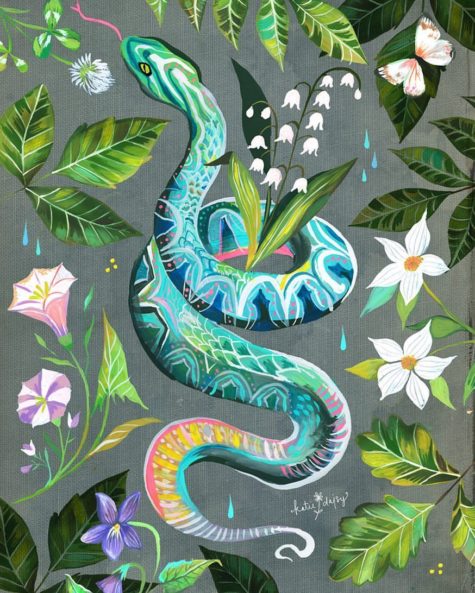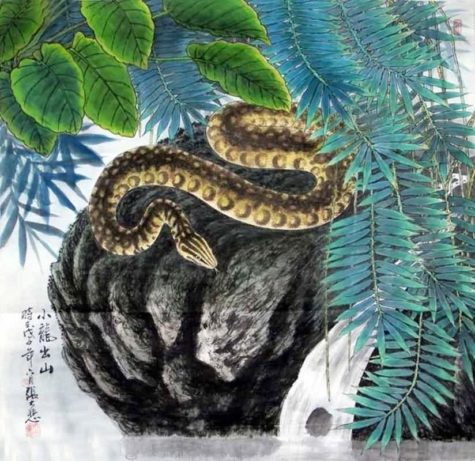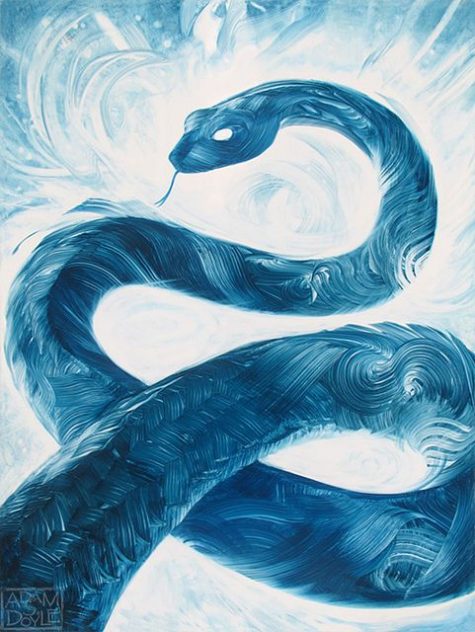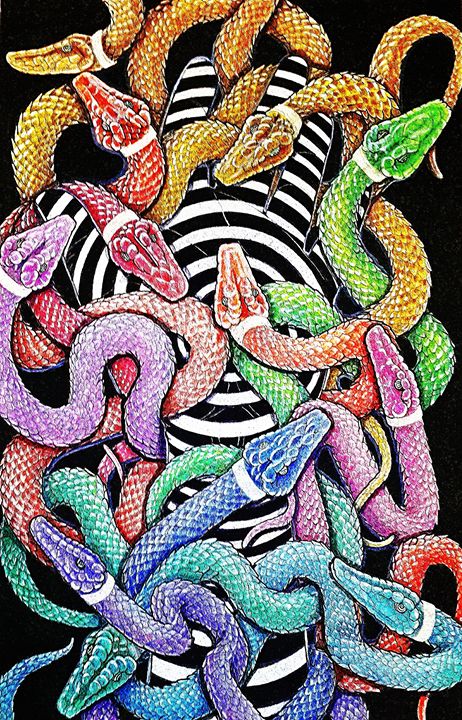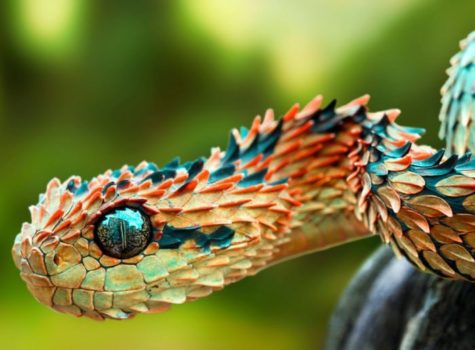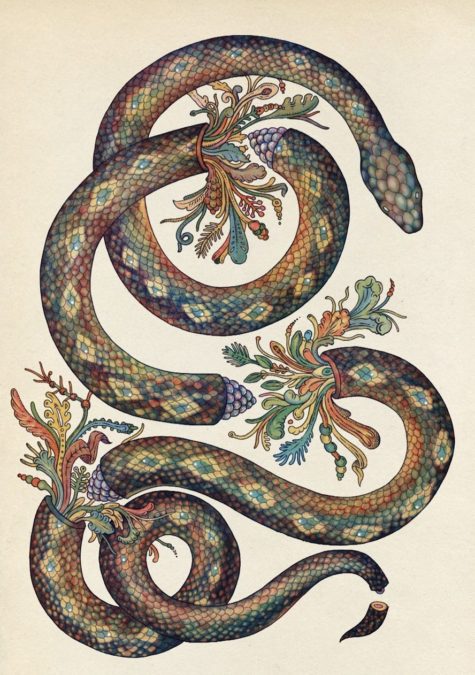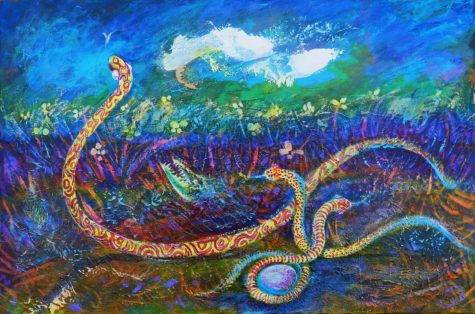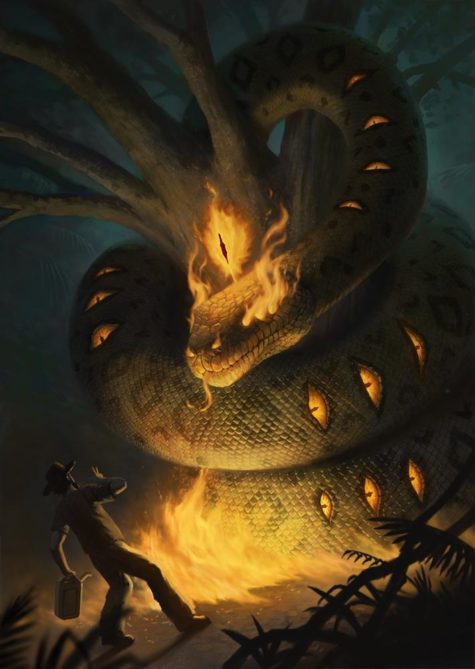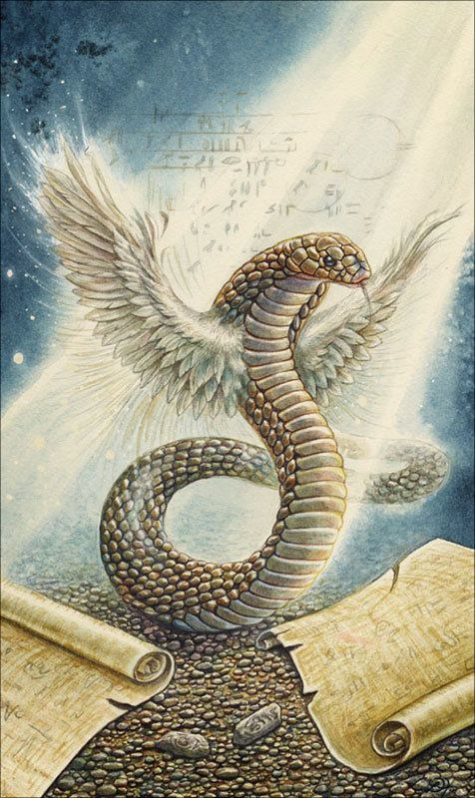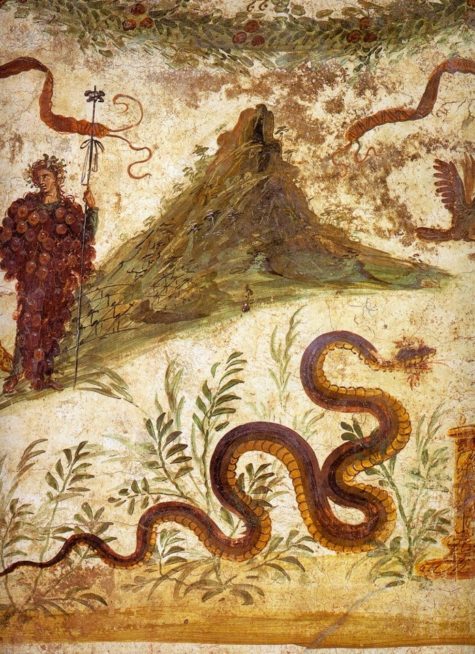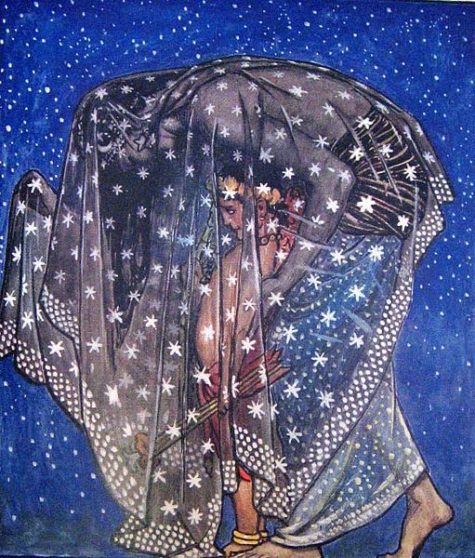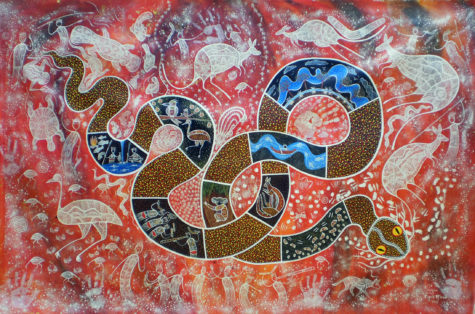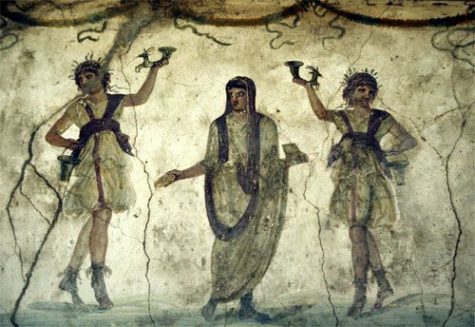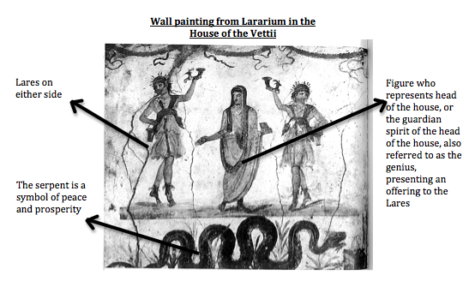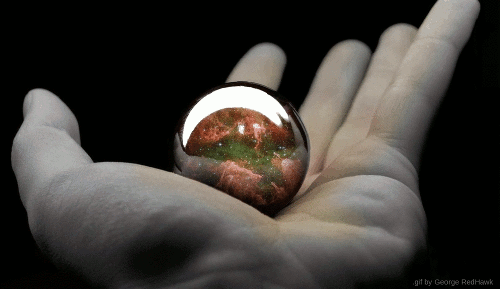Snake
The Magnificent Snake Totem possesses the following virtues:
Wisdom, healing, intuition, awaking of creative forces, ability to handle change without resistance, new opportunities for change, material vitality, intellect, power over rashness in speech and thought, emotional control, increased sensitivity to the environment, increased powers of smell, transmutation, and increased powers of observation.
When Snakes enter into your world expect swift changes to sweep through your life. These changes signify a death of the old and a birth into untapped power, creativity and wisdom. Snake is a powerful totem to have. Only those with a high degree of spiritual training, be it past or present, will be awarded this totem. It is the guardian of sacred places and the keeper of hidden knowledge.
Snake Symbolism
The snake is a symbol of transformation and healing. Anytime a snake shows up as a totem, you can expect death and rebirth to occur in some area of your life. This rarely reflects an actual death but rather a transition. Look for change in conditions and a movement to new life. Examine what is going on around you:
- Are you needing to make changes but aren’t for some reason?
- Are you trying to force change too quickly?
- Are you striking out at people and shouldn’t?
- Are you not striking and should?
- What is needing to be healed?
- What new opportunities are surfacing that you need to strike out for and take advantage of?
- When you are frightened, how do you bluff?
- Do you exaggerate your fears?
- Do you want to appear bigger or more important than you really are?
- Are you bluffing?
It can also reflect that your own creative forces are awakening. Spiritually, it can stimulate greater perception of how to apply your insight and intuition. Your own vision and intuition will become more accurate. Learning opportunities, formal and informal, will surface frequently. You will be able to swallow and digest whatever you take in.
Snakes have speed and agility, so those who have snakes come into their life will usually find the changes and shifts occur quickly and are soon recognized and defined. When snake comes into your life you can look for a rebirth into new powers of creativity and wisdom.
Snake Lore
The snake dwells in so many places, climates and environments, comes in so many colors, shapes and sizes that this creature can be said to be one of the most versatile of all. Indeed snakes represent versatility, transmutation and change, their natural inclination to “shed their skins” leaving behind the old, and adapting to the new, supports this idea.
The snake has been, throughout the ages, controversial in many regards. Some see the snake as a bearer of evil or bad news, but most see the snake as the healer and spiritual icon that it is. Like any creature, human or animal, they possess both noble and questionable qualities. Some people fear them and many more are charmed by them.
Most of us recognize the snake as the symbol of physicians and alchemists, which shows two snakes wrapped around a staff. This again, supports their totem reputation as healer. Snakes are highly respected in India and their lore and symbolism is highly regarded by their culture; Vitana, the mother of snakes, is the symbol of water and the underworld and the Goddess Shiva always wears snakes on her body as jewelry, which represents sexuality. Native Indians also see the snake as a representation of fertility and healing.
Those who are said to posses Snake like qualities have control over their emotions, excellent intuition and the ability to heal quickly. They are slow to anger but have enormous coiled power within them and will strike with control and precision when they must. Some snake type people, like their reptile counterparts, will give their opponent fair warning before striking, others will attack powerfully and without any warning. Snakes rarely, if ever, attack unless provoked, which is an excellent lesson for all of us to learn. Others should be on their guard when in snake territory and should respect the snake’s province.
Snakes awaken spiritual and magical intuition in the person who chooses this totem or is chosen by it. Snakes are associated with unseen creative forces at work. With the snake totem the powers of intuition and observation becomes keener and more precise. As snakes represent change and intuition the combination of these characteristics will allow for great new developments in life and the proper instinct for deciding which changes will be effective and which should not be made. They represent openness to new experiences, and thus, opened horizons.
The Snake in the wild is generally clam and peaceful. They hunt for food when hungry and can go long periods of time without eating again. They bask on warm rocks and will usually not attack unless prompted. To annoy or provoke a snake is a very unwise mistake, which many people make. Because of their calm and somewhat shy nature, many believe that they are too still or quiet to be much harm, however, as many have discovered, while a snake may seem as though it is still and unaware, if pressed they can and will deliver a dangerous blow or bite, sometimes without warning, that can leave permanent damage or even cause death to its victim.
Snakes are very sensitive to their environment, they are silent, calm creatures and seem to be very serene on the outside, but within this animal is coiled power that can deliver lethal blows, with well timed and startling accuracy. The snake is a powerful totem, symbolizing eternity, wisdom, transformation and intuition. Their wisdom is expressed as healer and the snake has been used as a symbol of this for centuries.
More Snake Lore
Snakes are fascinating creatures that deserve respect. Throughout history the snake has had many legends associated with it linking them to creation, fertility and transformation.
In Israel the snake was regarded as the earth mother and played a beneficial role in fertility. In Egypt the cobra was known for its ability to expand the upper neck into a disc shape by spreading its ribs which symbolized immortality. In Christian lore the snake is seen rising from the chalice of St. John wound around a cross sometimes portrayed with a woman’s head to symbolize lust and temptation. In Eastern cultures a snake rising up through the spine represents the kundalini, or life force being awakened.
One of snakes most noticeable characteristics is the regular shedding of its outer skin as it grows. Once the skin is shed, the old inner layer becomes the new outer layer and a new inner layer of skin begins to develop. Crawling out of its old skin is very significant for those with this medicine. It is a metaphor for how we shed old ways and habits as we grow into higher spiritual energy symbolizing the death and rebirth process. It is also associated with astral travel and out of body experiences.
The eyes of a snake are always open protected by immobile transparent scales. Prior to shedding its skin the snakes markings become obscure and the eyes appear opaque or blue. This gives it a trance like appearance as if it is looking right through you. Learning how to see into the hearts of others is part of what it teaches us.
Snake has been a symbol of life and sexuality for thousands of years in many cultures. It is a totem of power, renewal and transmutation. Soundless in motion and invisible at rest snakes are unable to produce their own body heat. They are often seen lying in the hot mid day sun. The suns warmth coupled with the snakes behavior regulates their body temperature. Not relying on the energy of food to generate body heat, they can survive on meager diets for extended periods of time. Those with this totem need very little food to energize themselves. They are usually cold and prefer warmer climates. Their body temperatures are often lower than normal.
Snakes lack eardrums and external ear openings but have small bones in the head that conduct sound. They are able to hear low frequency sounds and sense vibrations that travel through the earth. This links them to the underworld where secrets are stored. The snake symbolizes healing on a cellular level. Because their bodies are lightweight and flexible they have speed and agility.
Snake Beckoning Spells
The snake is the totem animal of prophets, so it’s no accident that the staffs of Asklepios, Hermes, and Moses were embellished with snakes. Over the centuries, magical divining women, from the Minoan snake goddess to Marie Laveau, have danced with serpents. There is even a traditional divination system that interprets the movements of snakes.
Because snakes are the repository of Earth’s wisdom, there are may reasons why one would wish to communicate with them. Snakes are among people’s primary magical teachers and are invoked in spells for childbirth, fertility, healing, protection and financial well-being.
That said, it may be easier for most people, for a variety of reasons, to access that knowledge through visions rather than actual contact.
The scent of lavender allegedly invokes the spiritual presence of serpents and the legendary Serpent Spirits. Here’s how to use it:
Place an image on an altar, either of a snake or of an affiliated deity – the Minoan Serpent Goddess for instance. Surround this with fresh lavender or warm the essential oil in an aroma burner. Call the spirit. Be prepared to explain why you have issued the invitation.
Do this spell before bedtime, to receive a visitation in your dreams.
Alternatively, you can burn yarrow. Yarrow smoke allegedly stimulates visions of shakes. Burn yarrow and allow the smoke to permeate the area. Have your questions or goals ready.
Dreaming Snakes – What does it mean?
Gillian Holloway, Ph.D. identifies being bitten by a snake as meaning different things. She says, “In many dreams a single snake will come to bite you, and you may in fact be bitten after a brief struggle. To your amazement though, you will not die, and may find that the situation is not as bad as you thought.”
According to Holloway you have this kind of dream if you are struggling with some problem, relationship or challenge. “Such a snake-ordeal is an important signal that you are going through a kind of initiation; a psychological and spiritual trial that has the potential to change your life for the better if you deal with it bravely and with a clear heart. You may have to give up something you thought you couldn’t, or take a stand for your principles or faith.”
- Other interpretations:
When one is bitten by a snake in a dream, this often actually points to overcoming a situation that appeared dire. The a snake bit dream may point to learning to overcome a situation and regain your power in life. Snake bites can be viewed as in injection of wisdom, rather than life threatening venom.
The Lotuko-speaking Lango of Africa believe that to dream that a snake bites you is a very bad omen. Immediately on waking you should bite a piece of charcoal and spit it out and then prick yourself with a thorn. This will avert the omen and even if you meet a snake, as you surely will, it will not bite you.
- An historical perspective:
In some cultures snakes are highly regarded and symbolize the ability to transcend into higher levels of consciousness or into areas of knowledge that exist outside perceived time and space. In the pre-Christian days, snakes were considered symbols of fertility, healing, and nurturing (the healing serpent representing a god). Post Adam and Eve, snakes are often considered symbols of temptation and evil, anger, and envy. Snakes emerging out of the ground may represent your unconscious or repressed materials coming to your conscious mind. Freud thought that the snake was a phallic symbol.
- You are not alone:
It is amazing how many people have snake dreams! Most snake dreams seem to be disturbing and they leave the dreamer feeling anxious and afraid. There are no simple interpretations to the snake dreams. Each dreamer must consider their own situation and all of the details of the dream. Sometimes snakes may be phallic symbols and other times they represent negativity in our lives that hampers our progress and constantly threatens us.
In the long run the snake may be a positive symbol; it may represent difficulties that lead us to the center of personality and result in feelings of completeness.
Is That Snake Poisonous?
Snakes that are members of the pit viper family are easy to distinguish:
- Identifying a poisonous snake by its pupils.
Harmless snakes have round pupils (the black part in the center of the eye). Poisonous snakes have egg-shaped or cat-like (elliptical) pupils. In good light, you easily can see the pupil shape from a safe distance because snakes cannot jump, nor can they strike, from more than one-third of their body length.
Poisonous snakes also have a conspicuous sensory area or pit (hence the name “pit viper”) on each side of the head. The pit looks somewhat like a nostril and helps the snake locate warm-bodied food. It is located about midway between and slightly below the eye and nostril. Harmless snakes do not have pits.
- Identifying a poisonous snake by its tail.
The underside scales of a poisonous snake’s tail go all the way across in a single row from the anal plate. The tip of the tail may have two scale rows. Nonpoisonous snakes have two rows of scales from the vent to the end of the tail. This characteristic also can be seen on skins that may have been shed.
- Other features may help you identify a poisonous snake at a distance:
Usually, poisonous snakes have a triangular (wide at the back and attached to a narrow neck) or “spade-shaped” head. Be aware that many other harmless snakes flatten their heads when threatened and may appear poisonous.
Usually, rattlesnakes sound a warning rattle (a buzz or a dry, whirring sound) when approached. However, many nonpoisonous snakes (black racers, corn snakes, rat snakes, milk snakes and pine snakes) and several poisonous snakes (copperhead and cottonmouth) often vibrate their tails when threatened. The sound produced by this vibration often imitates a rattle or hissing sound when the snake is sitting in dry grass or leaves.
Snakes with lengthwise-striped markings are nonpoisonous. Most solid-colored snakes also are nonpoisonous, except the adult western cottonmouth, which has dark crossbands that often are indistinct. If a snake is marked in any other way, use other characteristics for identification.
You easily can recognize young cottonmouths and copperheads by their bright yellow or greenish yellow tails.
Don’t Do This!
While researching snakes, I came across this nifty little tidbit. It’s a list of what not to do when it comes to snakes.
A. Don’t cross a snake’s path unless you slide or shuffle your feet.
B. You’ll have leg aches – other diseases – bad luck.
A. Don’t eat in front of a snake.
B. When you get older, your throat will close.
A. Don’t watch a snake swallow it’s food.
B. Your neck will swell up.
A. Don’t watch a water snake swallow.
B. You’ll lose your voice.
A. Don’t open your mouth when you see a snake.
B. He’ll jump in.
A. Don’t kill snakes or lizards.
B. It will make your heart small – dry up – you will get a crooked back.
A. Don’t burn a snake.
B. You’ll get sores – rash.
A. Don’t kill a snake when it is raining.
B. Lightning will strike your house.
A. Don’t put a snake in the open when dead.
B. The lighting will bring it back to life.
A. Don’t put a dead snake on a rock.
B. You’ll cause a thunderstorm – it will come back to life.
A. Don’t kill a snake with your hand.
B. Your hand will swell up.
A. Don’t go to the bathroom in front of a snake.
B. He will be jealous of your wife and turn her yellow.
A. Don’t pick up things between two fingers.
B. Only snakes do that.
A. Don’t watch snakes having intercourse.
B. You’ll go blind.
A. Don’t step on a snake.
B. Your legs will swell up – get crooked.
A. Don’t draw in the sand with your fingers.
B. Snakes will come to it.
A. Don’t talk about snakes.
B. They will come around.
A. Don’t laugh at a snake.
B. It will bite you.
A. Don’t make faces at a snake.
B. It will bite you some day.
A. Don’t spit at a snake.
B. It will get after you.
A. Don’t watch a snake crawl out of its skin.
B. You’ll get sick or jump out of your skin.
A. Don’t shoot an arrow at a snake.
B. It will go crooked – hit something else – be spoiled.
A. Don’t run over a snake in your car.
B. You’ll have a bad life.
A. Don’t break snake eggs.
B. The snakes will get you.
A. Don’t wear anything made out of snakeskin, especially boots or shoes.
B. You will get crippled.
A. Don’t touch a snake.
B. It has nothing and it will make you have nothing.
A. Don’t call a person a snake.
B. You’ll be bitten by one.
A. Don’t urinate on roads that cross each other.
B. That is the same as a snake trail
More Navajo snake taboos can be found here: Navajo Snake Superstitions.
Sources:
- Mani Zone
- Animal Speak
- Navajo Taboos; Ernie Bulow, 1991
- University of Missouri Extension Center
- The Element Encyclopedia of 5000 Spells
- Alternate Names: Baitatá, Biatatá, Bitatá, Batatão, Batatá, Mboitatá, M’boiguaçu, Mbaê-Tata
- Origins: Brazilian mythology, legend and folklore
- Element: Fire, Water
- Species: Serpent
- Appearance: Flaming, bright, giant horned aquatic serpent, or glowing eyes in the dark
- Powers: Protects the Rainforest
- Manifestation: A giant snake with enormous fiery eyes that crawls over the open fields at night. Sometimes described as a giant fire snake.
Boitatá is a mythological serpent from Brazilian mythology, legend and folklore. It is the Brazilian equivalent of the will-o’-the-wisp. The name comes from the Old Tupi language and means “fiery serpent” (mboî tatá). Its great fiery eyes leave it almost blind by day, but by night, it can see everything.
The Boitatá is a good entity, but it may kill anything which is violating the forests. Their diet consists of eyes from dead animals or its victims.
According to the legend, there was once a long period of darkness when the sun did not shine and a deluge flooded the earth. These conditions killed many animals and forced the beasts to flee their natural habitat. A “boiguaçu” (a cave anaconda) left its cave after the deluge and, in the dark, went through the fields preying on the animals and corpses, eating exclusively its favorite morsel, the eyes of the dead, which shone brightly in the darkness and made for tasty delicacies.
As the snake ate more and more of these delicious, shiny eyes, its body began to shine. The collected light from the eaten eyes gave “Boitatá” its fiery gaze, but the eyes-only diet steadily weakened it, and it perished… in a blaze of glory. For, upon its death, all the light collected inside it escaped to the sun, and the dark days were finally over.
There must have been some magic in all those eyeballs, because the boitatá lived on in spirit. It inhabits the Amazon jungles to this day, often appearing at night as nothing but two glowing, fiery eyes. Some say it can breathe fire as well, an ability it uses to incinerate people who harm the rainforest by chopping trees down or starting fires.
Others say it can actually disguise itself as a tree trunk, then roast alive any lumberjack who comes to cut it down. It is also said that it will blind you and make you insane if you gaze into its eyes.
Variations:
There are other versions of the legend that describe the boitatá as a giant, fiery bull who hunts the hunters, and yet others that associate it with almas penadas – souls that are cursed for various reasons, from immorality to dealing dishonestly with the devil.
Many descriptions of the boitatá legend connect it with ignis fatuus, or that fiery phenomenon known as the will-o’-the-wisp. There is some overlap between the legends of the boitatá and the boiúna, an evil black snake that is said to take a variety of forms, attack and devour people, and use its flaming eyes to lead boats to their ruin.
Sources:
- Title: The Good Spirit
- Other Names: Agathodemon, Agatho Daimon
- Origin: Egypt
- Preferred offering: Wine
- Manifestations: Consistently serpentine, he may appear as an ordinary snake or a hovering winged serpent.
Agathodaemon is a benevolent spirit of healing, protection, luck, and good fortune who manifests as a snake. Veneration of Agathodaemon traveled from Egypt to Greece and Italy. He is a consistently benevolent spirit. In Egypt, he evolved into a Gnostic guardian angel.
Agathodaemon is a companionable spirit. Among the deities with whom he happily shares altar space are Serapis, Tyche, and Hermes. He may be fond of Sicily’s Saint Agatha who may or may not be an ancient serpent-goddess in disguise.
Agathodaemon survives in modern Egypt, too, albeit undercover. Each of Cairo’s four quarters allegedly possesses its own snake-shaped guardian spirit, its own Agathodaemon.
The Greek version of this deity, is known by Agathos, or Agatho Daemon. Information on this version of the Serpent Spirit can be found here: Agathos.
Source: Encyclopedia of Spirits
- Also known as: Agatho Daemon
The Romans and Hellenistic Greeks did not like deities in the shapes of animals. They liked their spirits to resemble humans. Adopted Egyptian spirits thus adapted in form.
Agathos may be Agatho Daemon in human form; he may be an emanation of Agatho Daemon who developed into an independent spiritual entity; or he may always have been a distinct spirit.
Agathos is Lord of Vineyards and watches over fields of grain, peace, prosperity, and plenty. He bestows wisdom, good health, and good luck. Agathos was venerated at home, traditionally by a family together.
The worship of the Agatho Daimon was and is mostly a private practice. Greek families poured out a few drops of wine to him after every meal. Small offerings were sometimes left out to the daimon, which appeared as a snake around the household.
To honor the spirit, pour out libations to him, speak to him on a regular basis, asking for protection for yourself and your home. You might also make a sculpture of a snake to serve as a visual reminder of your daimon.
He shows his favor via a family’s good fortune (or lack thereof). Agathos guarantees that a family has sufficient food and drink.
- Favored people: Barkeeps, those who own vineyards or grow artisanal grain.
- Manifestations: Agathos manifests as a snake or a handsome young man.
- Attributes: Goblet, ear of wheat, poppies, cornucopia, staff or wand entwined by a snake.
- Offerings: Toast Agathos with a glass of wine at each meal; if you’re not drinking, then just set one aside for him.
The second day of every Athenian month was also a sacred day, devoted to the Agathos Daimon (good spirit). The name “daimon” does not mean the evil demon of modern Christianity, (although it did have a negative form, called the kakodaimon), but was thought to be an aspect of Zeus, as Zeus Ktesios, Charitodotes, and Epikarpios, titles as giver of increase and joy.
Agathos Daimon is most often represented in the form of a snake, a symbol of healing. However the daimon is also a function of one’s being, a characteristic inherently neither good nor bad. Hence, one prays for a good daimon, an eudaimon, and goodness from the gods for the coming month and also for the favor of father Zeus as Agathos Daimon.
Pindar, Socrates, Proclus and Plotinus mention their daemons as well. The spirit acts as a guardian against error and a guide in life.
Burkert (Greek Religion, p. 181) says that “One must be on good terms with it.” And Pindar sang that “The daimon active about me I will always consciously put to rights with me by cultivating him according to my means” (Pyth. 3.108f) and “The great mind of Zeus steers the daimon of the men whom he loves” (Pyth. 5.122f). The philosopher Sokratēs talks of his own daimon as a small voice which speaks to him and warns him to refrain from certain actions (Plato, Apology, 31d).
The myth of the Agatho Daemon can neither be proved nor disproved. “Agatho” stems from the Greek “to agathon,” meaning the highest or supreme good in a moral sense, summum bonum. Since the daemon brought both spiritual and material wealth to a household or person, the Agatho Daemon amounts to the “good spirit.”
Each person was assigned a daemon at birth, and the “good spirit” of the daemon protected and guided him through life. Sacrifices of milk and honey were made to the daemon on one’s birthday. Otherwise a cup of consecrated or spiritually pure wine was passed around at dinner, called the cup of the Agatho Daemon. As we shall see, these rituals were meant as an affirmation of life (and thus as an acknowledgement of death).
The Agatho Daemon was the “good” half of a good and evil duality. This duality was portrayed in frescoes as a serpent with the head of a lion with 7 or 12 solar rays emanating from it. The serpent portion was called the kakodaemon, representing the underworld and water, and the lion’s head was the Agatho Daemon, representing the solar fires.
The cosmic interpretation of the daemon as solar provider was tied to the household’s prosperity in the form of the genius. The lion-headed serpent was frequently pictured along with the household genius, the latter shown as a youth holding a horn of plenty and a bowl, or a poppy and ears of corn, representing the growth and abundance of harvest. The harvest imagery along with the serpent as rain and sun were all symbolic of a successful harvest.
Information about the Egyptian version of this deity, known as Agathodaemon, can be found here: Agathodaemon.
Information collected from various sources
- Names: Nit
- Attributes: Two arrows and a shield, shuttle
- Creatures: Crocodile, snake, bee
- Color: Green
- Plants: Flax, papyrus
- Favored people: Soldiers, hunters, weavers, artisans
The inscription on Neith’s temple in Sais in the Nile Delta (now modern Sa el-Hagar) read:
I am all that has been,
that is and that will be
No mortal has yet been able
to lift the veil that covers me.
Neith, the First One, the primordial goddess, was never born but always existed. Alternatively she is completely self-generated. Neith traveled from the deserts and oases of Libya to emerge as among the greatest of Egyptian goddesses. In one Egyptian creation myth, Neith brought forth Ra, the sun. Then she invented the shuttle and loom, put the sky on her loom, and wove the world into existence. Neith, the first to give birth, invented weaving. Her name may derive from a word for “to weave” or “to knit.”
She is called:
- The Oldest One
- Nurse of Crocodiles
- The Huntress
- Opener of the Ways
- Great Goddess
- Lady of the West
Mother of the Gods, goddess of war and the hunt, she is goddess of the lower heavens, a warrior goddess and protectress. Her name means “I have come from myself,” or self-begotten.
Eternal goddess, universal mother; the Spirit behind the Veil of Mysteries; World Body; Primal Abyss. Her cult was a very ancient one with two queens of the First Dynasty named after her. Often shown along side Selqet as mummy guardian and protectress of marriage. She wore the red crown of Lower Egypt. In her hands she held a bow and two arrows.
Neith is a goddess of hunting. She presides over crafts of all kinds, including witchcraft and warcraft. Amuletic weapons placed in the tomb to protect the deceased from evil spirits were consecrated to Neith. She is the judge of the Egyptian deities. After eighty years, when the lawsuit between Horus and Set in the Court of Deities was still not resolved, Neith was called in to render a decision to which all could defer. (She favored Horus but compensated Set. Neith has historically had a close positive relationship with Set.)
Her ceremonies were of a mystic nature. Neith was worshiped with Mysteries and lantern processions. In December (on or around December 8th), a great festival, called the Feast of Lamps, was held annually in her honor and, according to Herodotus, her devotees burned a multitude of lights in the open air all night during the celebration.
She is the patroness of domestic arts, weaving, hunting, medicine, war, and weapons. Turn to her when working with herbs, magick, healing, mystical knowledge, rituals, and meditation. She is the protectress of women and marriage.
She may be venerated independently or together with her son, Sobek. The Greeks identified her with Athena, also identified as originating in Libya. Many consider Athena to be a Greek path of Neith or at least a very closely related spirit.
Neith appears as an androgynous woman. She wears the red crown of Lower Egypt. She sometimes appears in the guise of a golden cobra, as well. In Iconography, she is customarily depicted with a green face and hands. Neith is portrayed suckling a crocodile at each breast.
The main imagery of Neith was as the deity of the unseen and limitless sky, as opposed to Nut and Hathor, who respectively represented the manifested night and day skies. Her epithet as the “Opener of the Sun’s Paths in all her stations” refers to how the sun is reborn (due to seasonal changes) at various points in the sky, under her control of all beyond the visible world, of which only a glimpse is revealed prior to dawn and after sunset.
It is at these changing points that Neith reigns as a form of sky goddess, where the sun rises and sets daily, or at its ‘first appearance’ to the sky above and below. It is at these points, beyond the sky that is seen, that her true power as the deity who creates life is manifested.
This ancient goddess represents the full ecliptic circle around the sky (above and below). It was this realm, the cosmos below the horizon, that Neith personified, for she is the complete sky which surrounds the upper and lower sky, and which exists beyond the horizon, and thereby beyond the skies themselves. Neith, then, is that portion of the cosmos which is not seen, and in which the sun is reborn daily, below the horizon which may reflect the statement assigned to Neith as “I come at dawn and at sunset daily.”
As the goddess of creation and weaving, she was said to reweave the world on her loom daily. An interior wall of the temple at Esna records an account of creation in which Neith brings forth from the primeval waters of the Nun the first land. All that she conceived in her heart comes into being, including the thirty deities. Having no known husband she has been described as “Virgin Mother Goddess.”
Unique Goddess, mysterious and great who came to be in the beginning and caused everything to come to be . . . the divine mother of Ra, who shines on the horizon…
Sources:
- Other names: Damballah Weddo, Da, Papa Damballa, Obatala
- Manifestation: Damballah is a huge snake, so big his body forms seven thousand coils
- Color: White
- Day: Thursday
- Plants: Bougainvillea, trees in general, but especially the silk cotton tree (Bombax ceiba) and the Royal palm.
- Altar: Keep shallow vessels of clean, fresh water for him to curl up inside.
- Holiday: March 17 (St. Patrick’s Day)
Once upon a time, there was only Damballah. He lay beneath Earth, a great snake, cushioning and protecting it from falling into the watery abyss below. Although he lay still for a long time, eventually he had to move. His movements raised mountains and created valleys. Stars were shaken up into the sky. Sacred waters were released, forming oceans, rivers, springs and streams.
The first rain began to fall, and Aido-Hwedo, in the guise of the first rainbow, appeared. Damballah and Aido-Hwedo fell in love. They remain in love today. The intensive all pervasive power of that love infiltrated the entire universe. That power is manifest in human beings in the form of white liquids: milk and semen.
Associated Catholic Saint Patrick (who drove the snakes out of Ireland), and sometimes also Moses, whose staff transformed into a snake to prove the power of God over that wielded by Egyptian priests, Damballah is the primordial snake Iwa of life, wealth and wisdom. He is venerated in Dahomey as well as Haitian Vodou. He may also survive in the New Orleans folk saint Blanc Dani.
Damballah is among the most beloved and important Iwa. He associated with creation and is viewed as a loving father to the world. His presence brings peace and harmony. He bestows wealth, prosperity, good health, and fertility to devotees and can expose the location of missing treasure.
Damballah and his true love, the rainbow serpent, maintain the balance of forces, which sustains all ife on Earth. As a source of life, he is also strongly associated with water and regulates moisture and the rain.
He is incredibly old and powerful and is usually not bothered for trivial matters. He can be extremely generous, however, and so may be approached when one is genuinely desperate or really in trouble. Despite his venerable age, he remains interested in people. He will engage in sacred marriages with women but also occasionally with men.
Dambullah appears in dreams. He does not communicate well. You must pay attention. He is so old and primal that he is pre-articulate; he emerges from a time before speech. Damballah may hiss or make whistling noises but does not speak human language.
When he possesses a human, he does not speak but instead only hisses and whistles. His movements are also snake-like, and can including slithering along the ground, flicking his tongue, and climbing tall objects.
He is a stickler for cleanliness. He doesn’t like strong, pervasive odors of any kind, but especially tobacco. If you smoke, then do so far from his altar space or anywhere associated with him. He may object to cleaning products with strong odors too, as well as air fresheners with strong aromas. Rooms should smell clean and fresh. Open a window to aerate them. He does not object to light floral odors, like rose or orange blossom water, and traditionally expresses a fondness for Pompeii Lotion, a cologne product found in botanicas and spiritual supply stores.
Offerings:
For a very traditional offering, make a bed or hill of white flour on a perfectly clean, pure white plate. Nestle one whole, raw white egg into the center of the flour and serve.
Other offerings could include white candles and white foods like rice, milk, whole raw eggs (leave them plain or rub gently with rose or other mildly scented, fine quality floral water), corn syrup, white chickens, or white flowers. More lavish offerings might include luxurious white fabrics, crystal or porcelain eggs and/or snakes.
Veve for Damballa and Ayida-Weddo:
From; Encyclopedia of Spirits
- Also known as: Lases (Etruscan); Lassi
- Manifestation: Lares usually come in pairs, either in human form or as snakes.
- Sacred animal: Dog; Snake
- Origin: Italy
- Feast: Dec 23, The Larentalia
Lares are guardian spirits. Lares is plural but that’s fitting because they virtually always manifest in pairs. The singular is Lar. They are found inside the home, on the property they protect and also at crossroads. They make their home with the family they protect, usually dwelling by the hearth or beside the chimney.
The Lares themselves are usually depicted as dancing youths, with a horn cup in one hand and a bowl in the other. As progenitors of the family, they were accompanied by symbolic phallic serpents.
There were many different types of guardians. The most important are the Lares Familiares (guardians of the family), Lares Domestici (guardians of the house), Lares Patrii (guardians of the fathers) and Lares Privati (personal guardians). Other guardians were the Lares Permarini (guardians of the sea), Lares Rurales (guardians of the land), Lares Compitales (guardians of crossroads), Lares Viales (guardians of travelers) and Lares Praestitis (guardians of the state).
The Lar Familiaris protected all household members, free or slave, and was associated with a particular place, thus did not accompany a family who moved. Tradition holds that a family’s Lar would generously help those who honored him by devotionals and sacrifices. But the Lar would turn his back to those who would not offer him thanks or neglected him.
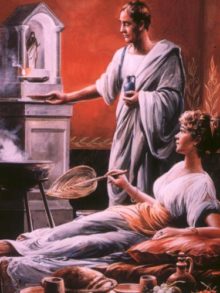 Presumed to be sons of Mercury and Lara, Lares are beneficent and friendly spirits, and deeply venerated by ancient Romans. In every house there was at least one little statue, and through these small statues, the Lare was presumed to take part in all that happened inside the house. Often a statue was put on the table during the meals, and other small statues were often placed in the higher places of the house, far from the floor, or even on the roof.
Presumed to be sons of Mercury and Lara, Lares are beneficent and friendly spirits, and deeply venerated by ancient Romans. In every house there was at least one little statue, and through these small statues, the Lare was presumed to take part in all that happened inside the house. Often a statue was put on the table during the meals, and other small statues were often placed in the higher places of the house, far from the floor, or even on the roof.
The Lares were worshiped in small sanctuaries or shrines, called Lararium, which could be found in every Roman house. They were placed in the atrium (the main room) or in the peristylium (a small open court) of the house. Here people sacrificed food to the Lares on holidays.
Care and attendance to domestic Lares could include offerings of spelt wheat and grain-garlands, honey cakes and honeycombs, grapes and first fruits, wine and incense. They could be served at any time and not always by intention: as well as the formal offerings that seem to have been their due, any food that fell to the floor during house banquets was theirs. On important occasions, wealthier households may have offered their own Lares a pig.
A household’s lararium, a shrine to the Lares Familiaris, usually stood near the hearth or in a corner of the atrium. A lararium often had the appearance of a cupboard or a niche containing a small statue, a niche painted on a wall, or a small freestanding shrine. Sometimes the Genius of the head of the household, pictured as a bearded or crested snake, or as a man with the fold of his toga covering his head, is depicted with the Lar.
Iconography: Lares are usually depicted as two young men with a watch dog; if depicted in serpentine form, then they may be crowned.
The Lares Compitales, the guardian spirits who protected local neighborhoods were housed in the crossroad shrines which served as a focus for the religious, social and political life of their local, overwhelmingly plebeian communities. Shrines were erected at crossroads. These shrines were usually open in all directions so that the Lares could travel as needed.
More about the Lares Compitales and their festival and feast days can be found here:

